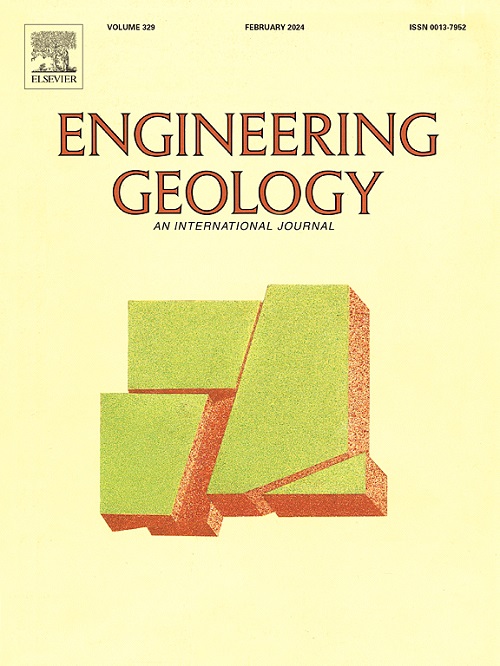激光破碎花岗岩的损伤表征:实验验证和数值模拟
IF 8.4
1区 工程技术
Q1 ENGINEERING, GEOLOGICAL
引用次数: 0
摘要
在硬岩掘进中,激光辅助破岩是一种很有前途的减少工具磨损的解决方案。然而,对激光破坏花岗岩的损伤表征,特别是微观损伤过程和矿物颗粒结构的影响的研究仍然有限。因此,本研究对激光(高斯光束,100-500 W, 30 s)照射下花岗岩的热断裂、温度分布和强度特性进行了研究。建立了基于颗粒的耦合模型(GBM)、内聚区模型(CZM)和热-机械损伤模型(TMD)来模拟激光损伤花岗岩。实验数据证实了该模型的准确性,在模拟热坑形成和热裂缝的产生和扩展方面优于其他模型。结果表明,随着激光功率的增大和照射时间的延长,热断裂程度增加。激光对花岗岩的损伤分为两个阶段:第一阶段与温度有关,第二阶段与激光参数呈线性关系(R2 = 0.9)。超过三分之二的损伤发生在晶界,损伤速率顺序为:绿泥石>;黑云母比;钠长石比;石英比;微斜长石。这些发现,特别是晶界处的高损伤率,增强了我们对激光破碎花岗岩特性及其矿物颗粒影响的理解,为优化激光破岩技术提供了理论支持,并为隧道开挖提供了潜在的成本节约和效率提高。本文章由计算机程序翻译,如有差异,请以英文原文为准。
Damage characterization of laser-fractured granite: experimental validation and numerical modeling
Laser-assisted rock-breaking is a promising solution to reduce tool wear in hard rock tunneling. However, research on damage characterization of laser-fractured granite, particularly microscopic damage processes and the effects of mineral grain structures, remains limited. Therefore, this study investigated thermal fracture, temperature distribution, and strength properties of granite under laser irradiation (Gaussian beam, 100–500 W, 30 s). A coupled grain-based model (GBM), cohesive zone model (CZM), and thermo-mechanical damage (TMD) model was developed to simulate laser-fractured granite. Experimental data confirmed the model's accuracy, which outperformed other models in simulating thermal crater formation and the generation and expansion of thermal cracks. Results showed that thermal fracture increased with laser power and irradiation duration. Laser-induced damage to granite occurs in two stages: Stage I is temperature-dependent, while Stage II shows a linear relationship with laser parameters (R2 = 0.9). Over two-thirds of the damage occurs at grain boundaries, with the damage rate following the order: Chlorite > Biotite > Albite > Quartz > Microcline. These findings, particularly the high damage rate at grain boundaries, enhance our understanding of laser-fractured granite properties and the impact of its mineral grains, providing theoretical support for optimizing laser rock-breaking technology and suggesting potential cost savings and efficiency improvements in tunnel excavation.
求助全文
通过发布文献求助,成功后即可免费获取论文全文。
去求助
来源期刊

Engineering Geology
地学-地球科学综合
CiteScore
13.70
自引率
12.20%
发文量
327
审稿时长
5.6 months
期刊介绍:
Engineering Geology, an international interdisciplinary journal, serves as a bridge between earth sciences and engineering, focusing on geological and geotechnical engineering. It welcomes studies with relevance to engineering, environmental concerns, and safety, catering to engineering geologists with backgrounds in geology or civil/mining engineering. Topics include applied geomorphology, structural geology, geophysics, geochemistry, environmental geology, hydrogeology, land use planning, natural hazards, remote sensing, soil and rock mechanics, and applied geotechnical engineering. The journal provides a platform for research at the intersection of geology and engineering disciplines.
 求助内容:
求助内容: 应助结果提醒方式:
应助结果提醒方式:


